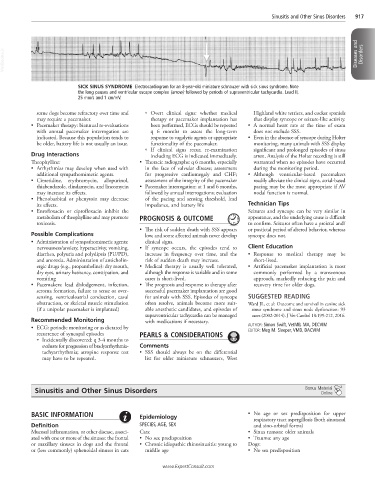Page 1831 - Cote clinical veterinary advisor dogs and cats 4th
P. 1831
Sinusitis and Other Sinus Disorders 917
VetBooks.ir Diseases and Disorders
SICK SINUS SYNDROME Electrocardiogram for an 8-year-old miniature schnauzer with sick sinus syndrome. Note
the long pauses and ventricular escape complex (arrow) followed by periods of supraventricular tachycardia. Lead II,
25 mm/s and 1 cm/mV.
some dogs become refractory over time and ○ Overt clinical signs: whether medical Highland white terriers, and cocker spaniels
may require a pacemaker. therapy or pacemaker implantation has that display syncope or seizure-like activity.
• Pacemaker therapy: biannual re-evaluations been performed, ECGs should be repeated • A normal heart rate at the time of exam
with annual pacemaker interrogation are q 6 months to assess the long-term does not exclude SSS.
indicated. Because this population tends to response to vagolytic agents or appropriate • Even in the absence of syncope during Holter
be older, battery life is not usually an issue. functionality of the pacemaker. monitoring, many animals with SSS display
○ If clinical signs recur, re-examination significant and prolonged episodes of sinus
Drug Interactions including ECG is indicated immediately. arrest. Analysis of the Holter recording is still
Theophylline: • Thoracic radiographs: q 6 months, especially warranted when no episodes have occurred
• Arrhythmias may develop when used with in the face of valvular disease; assessment during the monitoring period.
additional sympathomimetic agents. for progressive cardiomegaly and CHF; • Although ventricular-based pacemakers
• Cimetidine, erythromycin, allopurinol, assessment of the integrity of the pacemaker readily alleviate the clinical signs, atrial-based
thiabendazole, clindamycin, and lincomycin • Pacemaker interrogation: at 1 and 6 months, pacing may be the most appropriate if AV
may increase its effects. followed by annual interrogations; evaluation nodal function is normal.
• Phenobarbital or phenytoin may decrease of the pacing and sensing threshold, lead
its effects. impedance, and battery life Technician Tips
• Enrofloxacin or ciprofloxacin inhibit the Seizures and syncope can be very similar in
metabolism of theophylline and may promote PROGNOSIS & OUTCOME appearance, and the underlying cause is difficult
toxicosis. to confirm. Seizures often have a preictal and/
• The risk of sudden death with SSS appears or postictal period of altered behavior, whereas
Possible Complications low, and some affected animals never develop syncope does not.
• Administration of sympathomimetic agents: clinical signs.
nervousness/anxiety, hyperactivity, vomiting, • If syncope occurs, the episodes tend to Client Education
diarrhea, polyuria and polydipsia (PU/PD), increase in frequency over time, and the • Response to medical therapy may be
and anorexia. Administration of anticholin- risk of sudden death may increase. short-lived.
ergic drugs (e.g., propantheline): dry mouth, • Medical therapy is usually well tolerated, • Artificial pacemaker implantation is most
dry eyes, urinary hesitancy, constipation, and although the response is variable and in some commonly performed by a transvenous
vomiting cases is short-lived. approach, markedly reducing the pain and
• Pacemakers: lead dislodgement, infection, • The prognosis and response to therapy after recovery time for older dogs.
seroma formation, failure to sense or over- successful pacemaker implantation are good
sensing, ventriculoatrial conduction, caval for animals with SSS. Episodes of syncope SUGGESTED READING
obstruction, or skeletal muscle stimulation often resolve, animals become more suit- Ward JL, et al: Outcome and survival in canine sick
(if a unipolar pacemaker is implanted) able anesthetic candidates, and episodes of sinus syndrome and sinus node dysfunction: 93
supraventricular tachycardia can be managed cases (2002-2014). J Vet Cardiol 18:199-212, 2016.
Recommended Monitoring with medications if necessary.
• ECG: periodic monitoring or as dictated by AUTHOR: Simon Swift, VetMB, MA, DECVIM
EDITOR: Meg M. Sleeper, VMD, DACVIM
recurrence of syncopal episodes PEARLS & CONSIDERATIONS
○ Incidentally discovered: q 3-4 months to
evaluate for progression of bradyarrhythmia- Comments
tachyarrhythmia; atropine response test • SSS should always be on the differential
may have to be repeated. list for older miniature schnauzers, West
Sinusitis and Other Sinus Disorders Bonus Material
Online
BASIC INFORMATION Epidemiology • No age or sex predisposition for upper
respiratory tract aspergillosis (both sinonasal
Definition SPECIES, AGE, SEX and sino-orbital forms)
Mucosal inflammation, or other disease, associ- Cats: • Sinus tumors: older animals
ated with one or more of the sinuses: the frontal • No sex predisposition • Trauma: any age
or maxillary sinuses in dogs and the frontal • Chronic idiopathic rhinosinusitis: young to Dogs:
or (less commonly) sphenoidal sinuses in cats middle age • No sex predisposition
www.ExpertConsult.com

